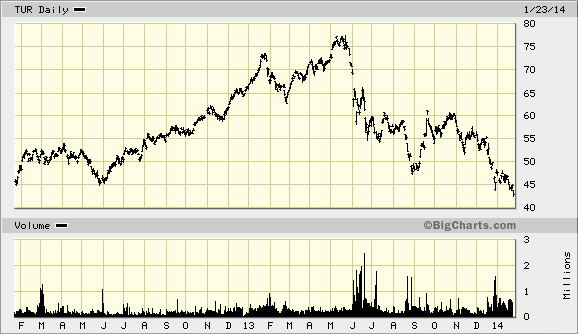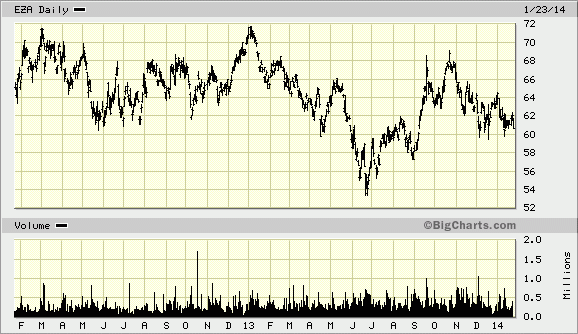Are investors too bullish on the stock market’s prospects for 2014 and too bearish for gold’s? It would certainly seem that way based on the near unanimity of analyst consensus. Most institutional analysts have published bullish forecasts for equities in 2014 and a bearish, or at least cautionary, outlook for gold. The favorable forecast for stocks and bearish gold outlook is based on the assumption that deflation remains at bay for the coming year.
But what if analyst expectations are disappointed and deflation rears its ugly head? That is precisely the scenario we’ll discuss here. For if deflation returns at some point this year it would easily upset the status quo for both asset categories.
Not without reason economists have recently turned their attention to the specter of deflation. Christine Lagarde, managing directly of the International Monetary Fund, last week stated her concern for a possible revival of deflation. “If inflation is the genie, then deflation is the ogre that must be fought decisively,” she said. Lagarde’s comment came out of left field considering that most economists have assumed that inflation, not deflation, is the new watchword. Could it be that Lagarde is more perceptive than most economists? Does she know something that most of us don’t?
This sudden return of the “d-word” to the limelight is actually quite timely. In view of the upcoming 60-year Kress cycle bottom in September, the long-term cycle of deflation is currently in its final “hard down” phase. And while it would be easy to sneer at a miniscule eight months, a lot can go wrong in eight months (as the events of the last few years have shown).
The Financial Times has astutely observed that “it is hard to remember a period, other than in the months immediately following the financial crash of 2008, when core and headline inflation has been so low in so many different economies.” This in spite of the record levels of liquidity that central banks have foisted upon financial markets. The fact that inflation hasn’t become a problem is due solely to the undercurrent of deflation courtesy of the long-term deflationary cycle that is scheduled to bottom late this year.
With a growing number of economists becoming aware of a potential deflationary event in 2014, central banks have been even more vigilant. The ECB is expected to expand its balance sheet even more this year in response to the decline in the euro zone’s core inflation rate. Dr. Ed Yardeni highlighted the potential risk of a deflationary revival in a recent blog posting. He noted that initially deflation might actually be bullish for stocks, even causing a “melt-up” since central bankers would respond to it be injecting more liquidity in the system.
He added that if deflation prevails, however, a melt-up would most likely be followed by a melt-down, which in turn would worsen the deflation. “In general,” he wrote, “falling consumer prices would be bad for corporate earnings.”
As for gold, many analysts erroneously assume that gold can only benefit from inflation. Samuel Kress maintained that gold performs best as a safe haven investment during two phases of the 60-year inflation/deflation cycle: the final "hyper-inflationary" phase of the cycle (e.g. late 1970s) and the final "hyper-deflationary" phase (e.g. the last 10 years or so). With deflation comes investor uncertainty, which in turn causes them to search for financial safe havens. Gold and bonds are the two most obvious choices in the minds of most investors in times of uncertainty. Indeed, as the last 10-15 years have shown that both gold and Treasuries benefit more from deflation than from inflation.
What could go wrong for equities in 2014? A revival of deflation could easily emanate from a credit crisis in China. China’s stock market is reflecting the growing debt problem in China. Below is a chart showing the Shanghai Composite index. A debt-laden and slower growing China could have repercussions on the global economy, including the U.S. economic and equity market outlook, for 2014. Should China’s problems begin to weigh on the U.S. and Europe, a gradual return to the safe havens of gold and Treasuries could emerge later in the year.
Also worth noting is that despite its internal economic problems, China’s gold demand has shown a dramatic increase in the past year. Even more demand is expected heading into the start of the Chinese lunar New Year on Jan. 31. Bloomberg reports that contracts traded on the Shanghai Gold Exchange jumped to a one-week high on Monday. Last year, the Chinese imported an estimated 1,000 tons of gold, which more than offset the decline in gold-backed ETF holdings, according to Sharps Pixley.
If China’s voracious appetite for gold continues in 2014, even in the face of a slowing economy on the home front, it could add even more impetus to a turnaround for the yellow metal later this year. Moreover, a palpable slowdown in China would eventually be felt in the U.S. and would give investors pause to reconsider gold as an investment safe haven as financial market volatility increases.
It’s worth mentioning that Bank of America Merrill Lynch strategist David Hauner has noted that commodity prices are back to the “ominous” highs of 2008 in South Africa and Turkey. He believes this divergence “will have a significant impact on growth and inflation in 2014: weak pricing power means that higher commodity prices act as a tax on demand, slowing down growth and thus ultimately reigning in current account deficits and inflation.”
Incidentally, take a look at the iShares MSCI Turkey ETF (TUR) which reflects the stock market situation in that corner of the globe. This provides us with a simple overview of the tenuous economic situation in the Middle East region.
South Africa’s stock market isn’t too far behind Turkey’s in terms of global underperformance (below).
In his latest research report, Hauner observed concerning China that the country’s “rebalancing is a closely connected disinflationary factor.” He added that consumer prices in Europe, the Middle East and Africa “are highly correlated with China’s with a lag of a few months. In fact, the betas to China and to commodities are themselves highly correlated, likely as demand in China is the key factor driving both.”
He concludes that the sharp drop in China's headline inflation from 3.2% to 2.5% “is likely to have a dampening effect” on consumer prices in Europe, the Middle East and Africa in the coming months.
In other words, Hauner’s analysis loosely corresponds with mine that a pick-up in deflationary pressure is possible further into 2014, which in turn could increase financial market volatility and possibly lead to gold’s return to favor among investors.
Gold And Gold Stock Trading Simplified
There exist several fantastic opportunities for capturing profits and maximizing gains in the precious metals arena. Yet a common complaint is that small-to-medium sized traders have a hard time knowing when to buy and when to take profits. Some complain of being unable to “pull the trigger” on a trade when the right time comes to buy.
Not surprisingly, many traders and investors are looking for a reliable and easy-to-follow system for participating in the precious metals bull market. They want a system that allows them to enter without guesswork and one that gets them out at the appropriate time and without any undue risks. They also want a system that automatically takes profits at precise points along the way while adjusting the stop loss continuously so as to lock in gains and minimize potential losses from whipsaws.
In my book, Gold & Gold Stock Trading Simplified, I remove the mystique behind gold and gold stock trading and reveal a completely simple and reliable system that allows the small-to-mid-size trader to profit from both up and down moves in the mining stock market. It’s the same system that I use each day in the Gold & Silver Stock Report – the same system which has consistently generated profits for my subscribers and has kept them on the correct side of the gold and mining stock market for years.
The methods revealed in Gold & Gold Stock Trading Simplified are the product of several year’s worth of writing, research and real time market trading/testing. It also contains the benefit of my 14 years worth of experience as a professional in the precious metals and PM mining share sector. The trading techniques discussed in the book have been carefully calibrated to match today’s fast moving and volatile market environment. You won’t find a more timely and useful book than this for capturing profits in today’s gold and gold stock market.
- English (UK)
- English (India)
- English (Canada)
- English (Australia)
- English (South Africa)
- English (Philippines)
- English (Nigeria)
- Deutsch
- Español (España)
- Español (México)
- Français
- Italiano
- Nederlands
- Português (Portugal)
- Polski
- Português (Brasil)
- Русский
- Türkçe
- العربية
- Ελληνικά
- Svenska
- Suomi
- עברית
- 日本語
- 한국어
- 简体中文
- 繁體中文
- Bahasa Indonesia
- Bahasa Melayu
- ไทย
- Tiếng Việt
- हिंदी
What Could Go Wrong For Stocks — And Right For Gold — In 2014?
Published 01/23/2014, 01:50 PM
Updated 07/09/2023, 06:31 AM
What Could Go Wrong For Stocks — And Right For Gold — In 2014?
Latest comments
Install Our App
Risk Disclosure: Trading in financial instruments and/or cryptocurrencies involves high risks including the risk of losing some, or all, of your investment amount, and may not be suitable for all investors. Prices of cryptocurrencies are extremely volatile and may be affected by external factors such as financial, regulatory or political events. Trading on margin increases the financial risks.
Before deciding to trade in financial instrument or cryptocurrencies you should be fully informed of the risks and costs associated with trading the financial markets, carefully consider your investment objectives, level of experience, and risk appetite, and seek professional advice where needed.
Fusion Media would like to remind you that the data contained in this website is not necessarily real-time nor accurate. The data and prices on the website are not necessarily provided by any market or exchange, but may be provided by market makers, and so prices may not be accurate and may differ from the actual price at any given market, meaning prices are indicative and not appropriate for trading purposes. Fusion Media and any provider of the data contained in this website will not accept liability for any loss or damage as a result of your trading, or your reliance on the information contained within this website.
It is prohibited to use, store, reproduce, display, modify, transmit or distribute the data contained in this website without the explicit prior written permission of Fusion Media and/or the data provider. All intellectual property rights are reserved by the providers and/or the exchange providing the data contained in this website.
Fusion Media may be compensated by the advertisers that appear on the website, based on your interaction with the advertisements or advertisers.
Before deciding to trade in financial instrument or cryptocurrencies you should be fully informed of the risks and costs associated with trading the financial markets, carefully consider your investment objectives, level of experience, and risk appetite, and seek professional advice where needed.
Fusion Media would like to remind you that the data contained in this website is not necessarily real-time nor accurate. The data and prices on the website are not necessarily provided by any market or exchange, but may be provided by market makers, and so prices may not be accurate and may differ from the actual price at any given market, meaning prices are indicative and not appropriate for trading purposes. Fusion Media and any provider of the data contained in this website will not accept liability for any loss or damage as a result of your trading, or your reliance on the information contained within this website.
It is prohibited to use, store, reproduce, display, modify, transmit or distribute the data contained in this website without the explicit prior written permission of Fusion Media and/or the data provider. All intellectual property rights are reserved by the providers and/or the exchange providing the data contained in this website.
Fusion Media may be compensated by the advertisers that appear on the website, based on your interaction with the advertisements or advertisers.
© 2007-2024 - Fusion Media Limited. All Rights Reserved.
